Critical Evaluation Report: PICC, Nursing, and Research Findings
VerifiedAdded on 2022/12/27
|8
|2348
|62
Report
AI Summary
This report presents a critical evaluation of a research article focusing on peripherally inserted central catheters (PICC) and their application in nursing practice. The report begins with an overview of the article's PICO elements, journal quality, and author credentials, followed by an assessment of the title, abstract, and literature review. It delves into the research design, including the use of a pilot randomized controlled trial, the sample selection, and data collection methods. The data analysis techniques and key findings are then discussed, highlighting the relevance of the study to nursing practice. The report also examines the study's outcomes, such as the comparison of hydrophobic polyurethane PICC with standard polyurethane PICC to prevent catheter failure and related complications. Furthermore, it explores secondary outcomes like phlebitis, safety endpoints, and PICC dwell time. The report concludes with a critical analysis of the study's implications for nursing practice, emphasizing the need for further research and its significance for improving patient care and outcomes. The report also provides a comprehensive list of cited references.
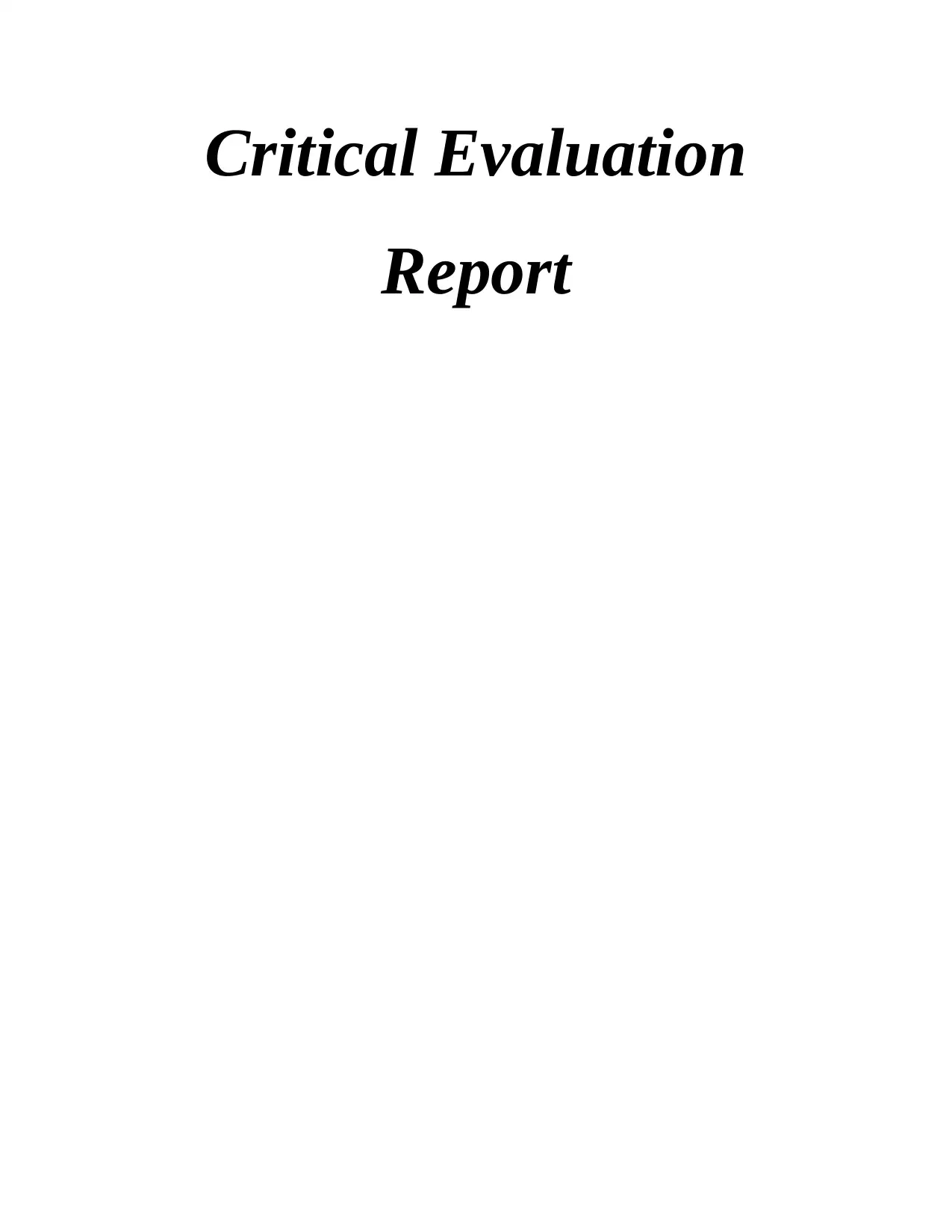
Critical Evaluation
Report
Report
Paraphrase This Document
Need a fresh take? Get an instant paraphrase of this document with our AI Paraphraser
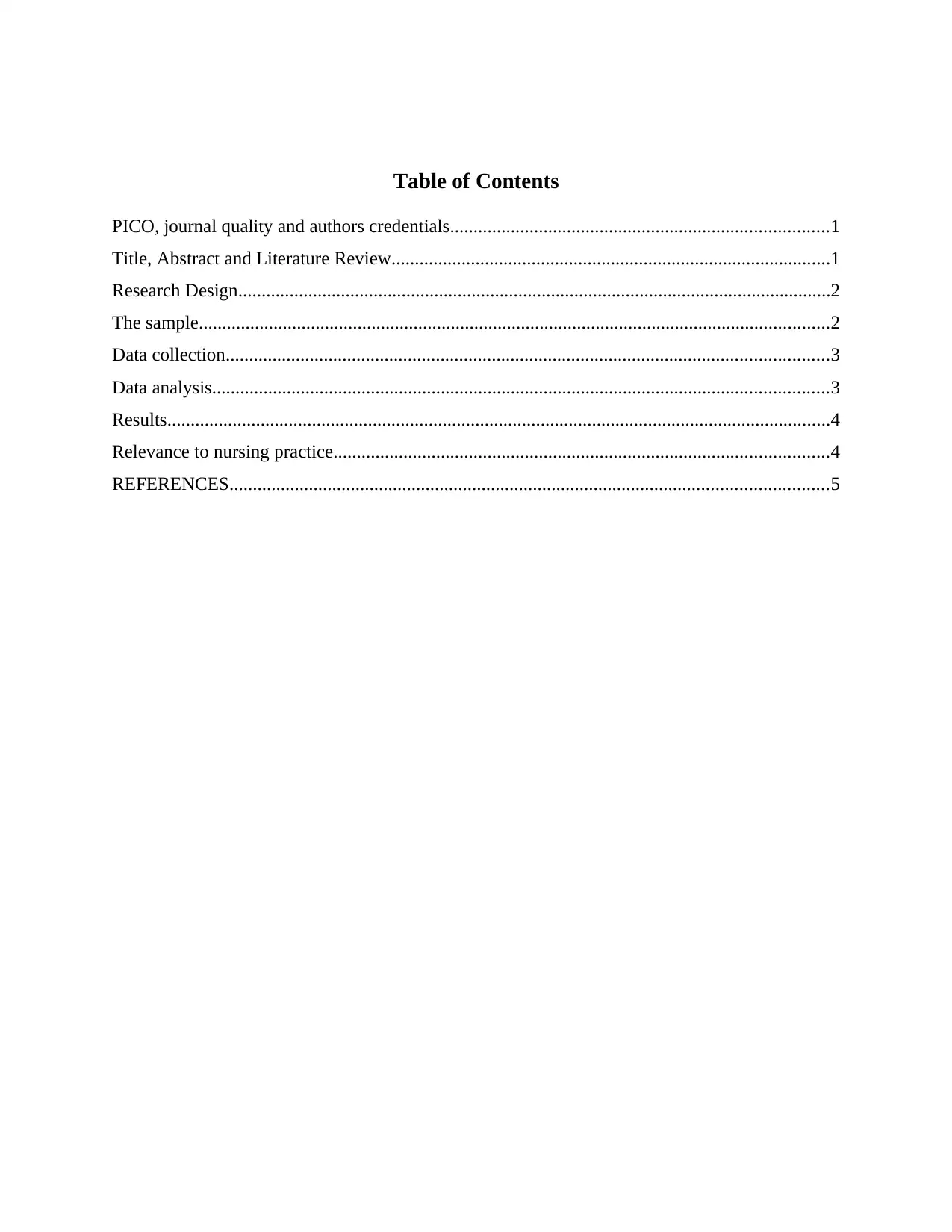
Table of Contents
PICO, journal quality and authors credentials.................................................................................1
Title, Abstract and Literature Review..............................................................................................1
Research Design...............................................................................................................................2
The sample.......................................................................................................................................2
Data collection.................................................................................................................................3
Data analysis....................................................................................................................................3
Results..............................................................................................................................................4
Relevance to nursing practice..........................................................................................................4
REFERENCES................................................................................................................................5
PICO, journal quality and authors credentials.................................................................................1
Title, Abstract and Literature Review..............................................................................................1
Research Design...............................................................................................................................2
The sample.......................................................................................................................................2
Data collection.................................................................................................................................3
Data analysis....................................................................................................................................3
Results..............................................................................................................................................4
Relevance to nursing practice..........................................................................................................4
REFERENCES................................................................................................................................5
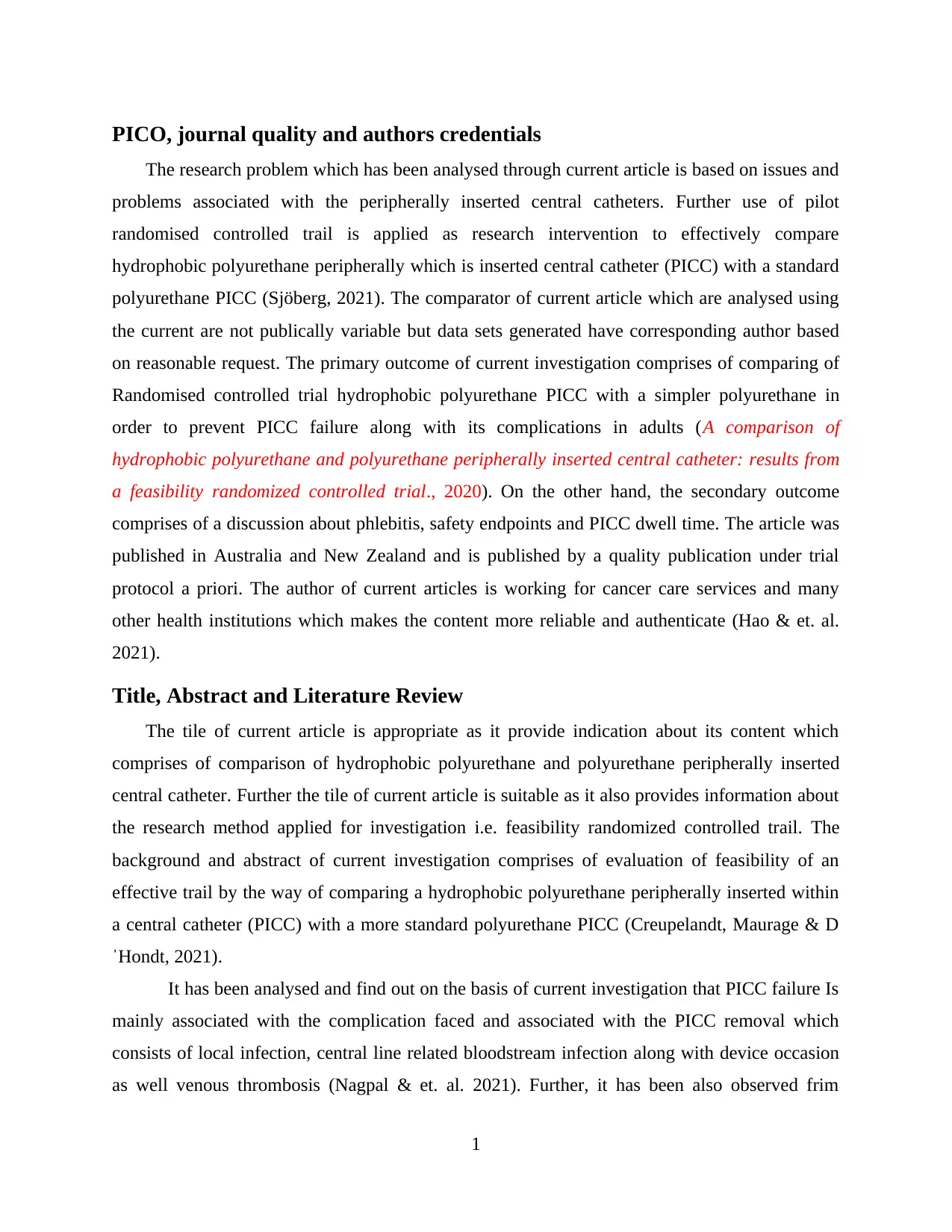
PICO, journal quality and authors credentials
The research problem which has been analysed through current article is based on issues and
problems associated with the peripherally inserted central catheters. Further use of pilot
randomised controlled trail is applied as research intervention to effectively compare
hydrophobic polyurethane peripherally which is inserted central catheter (PICC) with a standard
polyurethane PICC (Sjöberg, 2021). The comparator of current article which are analysed using
the current are not publically variable but data sets generated have corresponding author based
on reasonable request. The primary outcome of current investigation comprises of comparing of
Randomised controlled trial hydrophobic polyurethane PICC with a simpler polyurethane in
order to prevent PICC failure along with its complications in adults (A comparison of
hydrophobic polyurethane and polyurethane peripherally inserted central catheter: results from
a feasibility randomized controlled trial., 2020). On the other hand, the secondary outcome
comprises of a discussion about phlebitis, safety endpoints and PICC dwell time. The article was
published in Australia and New Zealand and is published by a quality publication under trial
protocol a priori. The author of current articles is working for cancer care services and many
other health institutions which makes the content more reliable and authenticate (Hao & et. al.
2021).
Title, Abstract and Literature Review
The tile of current article is appropriate as it provide indication about its content which
comprises of comparison of hydrophobic polyurethane and polyurethane peripherally inserted
central catheter. Further the tile of current article is suitable as it also provides information about
the research method applied for investigation i.e. feasibility randomized controlled trail. The
background and abstract of current investigation comprises of evaluation of feasibility of an
effective trail by the way of comparing a hydrophobic polyurethane peripherally inserted within
a central catheter (PICC) with a more standard polyurethane PICC (Creupelandt, Maurage & D
ˈHondt, 2021).
It has been analysed and find out on the basis of current investigation that PICC failure Is
mainly associated with the complication faced and associated with the PICC removal which
consists of local infection, central line related bloodstream infection along with device occasion
as well venous thrombosis (Nagpal & et. al. 2021). Further, it has been also observed frim
1
The research problem which has been analysed through current article is based on issues and
problems associated with the peripherally inserted central catheters. Further use of pilot
randomised controlled trail is applied as research intervention to effectively compare
hydrophobic polyurethane peripherally which is inserted central catheter (PICC) with a standard
polyurethane PICC (Sjöberg, 2021). The comparator of current article which are analysed using
the current are not publically variable but data sets generated have corresponding author based
on reasonable request. The primary outcome of current investigation comprises of comparing of
Randomised controlled trial hydrophobic polyurethane PICC with a simpler polyurethane in
order to prevent PICC failure along with its complications in adults (A comparison of
hydrophobic polyurethane and polyurethane peripherally inserted central catheter: results from
a feasibility randomized controlled trial., 2020). On the other hand, the secondary outcome
comprises of a discussion about phlebitis, safety endpoints and PICC dwell time. The article was
published in Australia and New Zealand and is published by a quality publication under trial
protocol a priori. The author of current articles is working for cancer care services and many
other health institutions which makes the content more reliable and authenticate (Hao & et. al.
2021).
Title, Abstract and Literature Review
The tile of current article is appropriate as it provide indication about its content which
comprises of comparison of hydrophobic polyurethane and polyurethane peripherally inserted
central catheter. Further the tile of current article is suitable as it also provides information about
the research method applied for investigation i.e. feasibility randomized controlled trail. The
background and abstract of current investigation comprises of evaluation of feasibility of an
effective trail by the way of comparing a hydrophobic polyurethane peripherally inserted within
a central catheter (PICC) with a more standard polyurethane PICC (Creupelandt, Maurage & D
ˈHondt, 2021).
It has been analysed and find out on the basis of current investigation that PICC failure Is
mainly associated with the complication faced and associated with the PICC removal which
consists of local infection, central line related bloodstream infection along with device occasion
as well venous thrombosis (Nagpal & et. al. 2021). Further, it has been also observed frim
1
⊘ This is a preview!⊘
Do you want full access?
Subscribe today to unlock all pages.

Trusted by 1+ million students worldwide
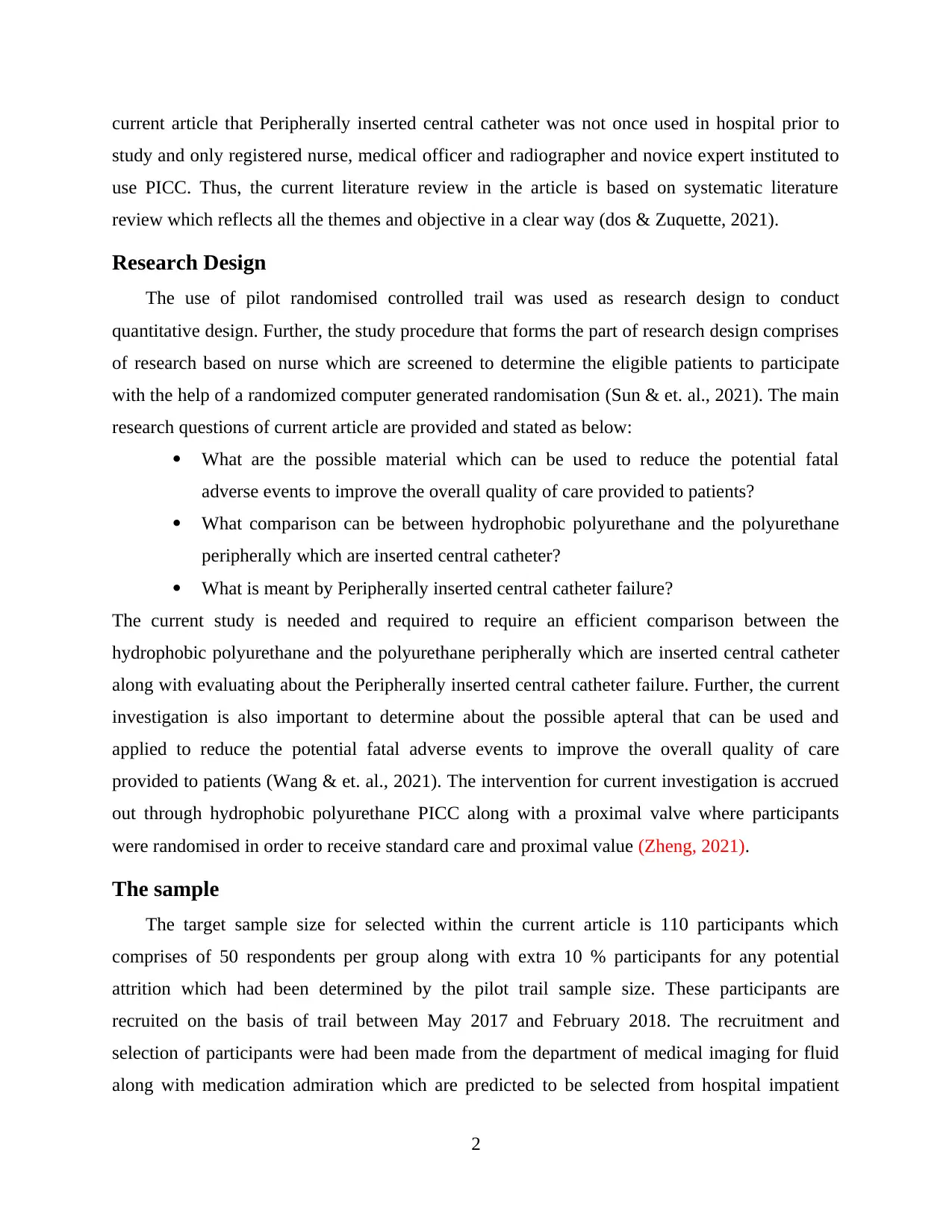
current article that Peripherally inserted central catheter was not once used in hospital prior to
study and only registered nurse, medical officer and radiographer and novice expert instituted to
use PICC. Thus, the current literature review in the article is based on systematic literature
review which reflects all the themes and objective in a clear way (dos & Zuquette, 2021).
Research Design
The use of pilot randomised controlled trail was used as research design to conduct
quantitative design. Further, the study procedure that forms the part of research design comprises
of research based on nurse which are screened to determine the eligible patients to participate
with the help of a randomized computer generated randomisation (Sun & et. al., 2021). The main
research questions of current article are provided and stated as below:
What are the possible material which can be used to reduce the potential fatal
adverse events to improve the overall quality of care provided to patients?
What comparison can be between hydrophobic polyurethane and the polyurethane
peripherally which are inserted central catheter?
What is meant by Peripherally inserted central catheter failure?
The current study is needed and required to require an efficient comparison between the
hydrophobic polyurethane and the polyurethane peripherally which are inserted central catheter
along with evaluating about the Peripherally inserted central catheter failure. Further, the current
investigation is also important to determine about the possible apteral that can be used and
applied to reduce the potential fatal adverse events to improve the overall quality of care
provided to patients (Wang & et. al., 2021). The intervention for current investigation is accrued
out through hydrophobic polyurethane PICC along with a proximal valve where participants
were randomised in order to receive standard care and proximal value (Zheng, 2021).
The sample
The target sample size for selected within the current article is 110 participants which
comprises of 50 respondents per group along with extra 10 % participants for any potential
attrition which had been determined by the pilot trail sample size. These participants are
recruited on the basis of trail between May 2017 and February 2018. The recruitment and
selection of participants were had been made from the department of medical imaging for fluid
along with medication admiration which are predicted to be selected from hospital impatient
2
study and only registered nurse, medical officer and radiographer and novice expert instituted to
use PICC. Thus, the current literature review in the article is based on systematic literature
review which reflects all the themes and objective in a clear way (dos & Zuquette, 2021).
Research Design
The use of pilot randomised controlled trail was used as research design to conduct
quantitative design. Further, the study procedure that forms the part of research design comprises
of research based on nurse which are screened to determine the eligible patients to participate
with the help of a randomized computer generated randomisation (Sun & et. al., 2021). The main
research questions of current article are provided and stated as below:
What are the possible material which can be used to reduce the potential fatal
adverse events to improve the overall quality of care provided to patients?
What comparison can be between hydrophobic polyurethane and the polyurethane
peripherally which are inserted central catheter?
What is meant by Peripherally inserted central catheter failure?
The current study is needed and required to require an efficient comparison between the
hydrophobic polyurethane and the polyurethane peripherally which are inserted central catheter
along with evaluating about the Peripherally inserted central catheter failure. Further, the current
investigation is also important to determine about the possible apteral that can be used and
applied to reduce the potential fatal adverse events to improve the overall quality of care
provided to patients (Wang & et. al., 2021). The intervention for current investigation is accrued
out through hydrophobic polyurethane PICC along with a proximal valve where participants
were randomised in order to receive standard care and proximal value (Zheng, 2021).
The sample
The target sample size for selected within the current article is 110 participants which
comprises of 50 respondents per group along with extra 10 % participants for any potential
attrition which had been determined by the pilot trail sample size. These participants are
recruited on the basis of trail between May 2017 and February 2018. The recruitment and
selection of participants were had been made from the department of medical imaging for fluid
along with medication admiration which are predicted to be selected from hospital impatient
2
Paraphrase This Document
Need a fresh take? Get an instant paraphrase of this document with our AI Paraphraser
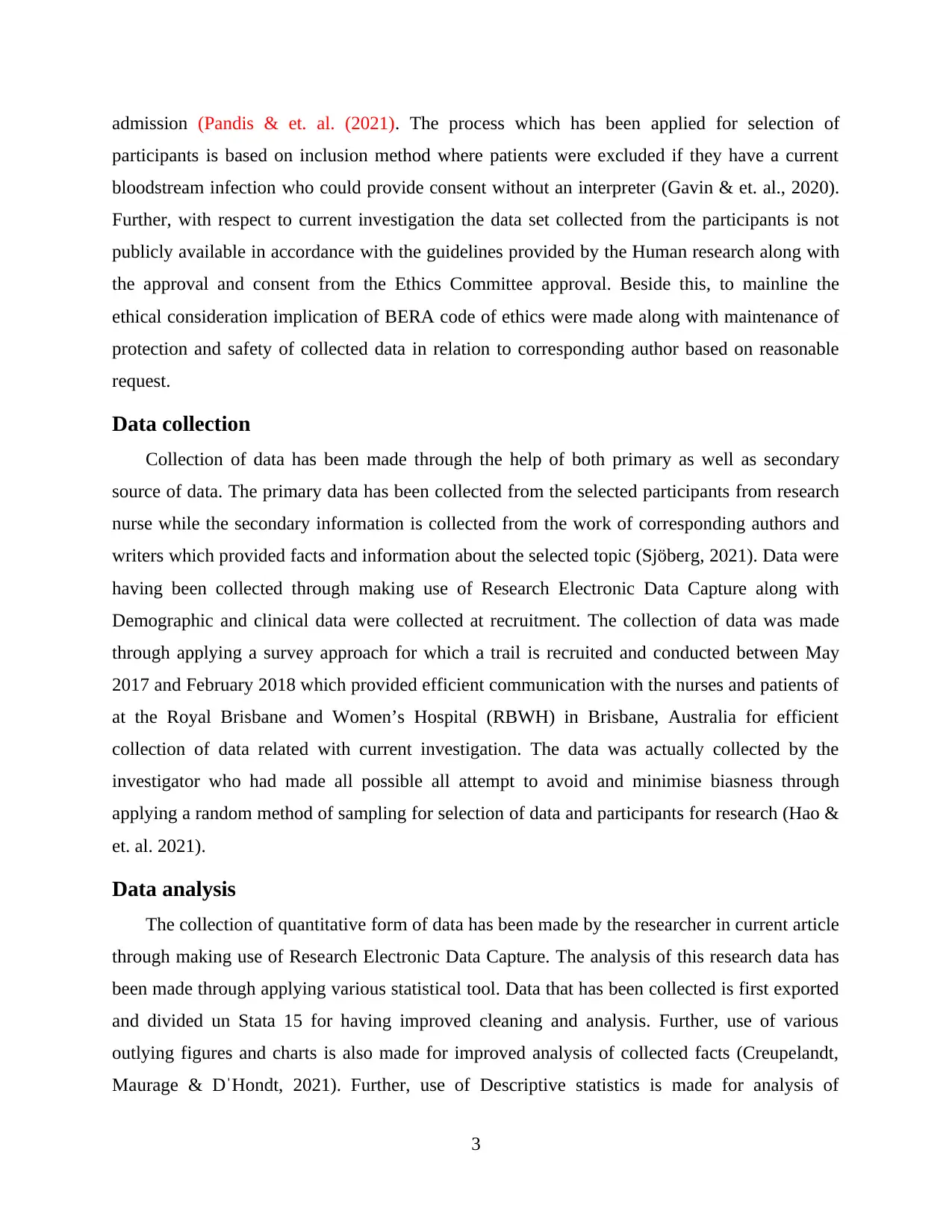
admission (Pandis & et. al. (2021). The process which has been applied for selection of
participants is based on inclusion method where patients were excluded if they have a current
bloodstream infection who could provide consent without an interpreter (Gavin & et. al., 2020).
Further, with respect to current investigation the data set collected from the participants is not
publicly available in accordance with the guidelines provided by the Human research along with
the approval and consent from the Ethics Committee approval. Beside this, to mainline the
ethical consideration implication of BERA code of ethics were made along with maintenance of
protection and safety of collected data in relation to corresponding author based on reasonable
request.
Data collection
Collection of data has been made through the help of both primary as well as secondary
source of data. The primary data has been collected from the selected participants from research
nurse while the secondary information is collected from the work of corresponding authors and
writers which provided facts and information about the selected topic (Sjöberg, 2021). Data were
having been collected through making use of Research Electronic Data Capture along with
Demographic and clinical data were collected at recruitment. The collection of data was made
through applying a survey approach for which a trail is recruited and conducted between May
2017 and February 2018 which provided efficient communication with the nurses and patients of
at the Royal Brisbane and Women’s Hospital (RBWH) in Brisbane, Australia for efficient
collection of data related with current investigation. The data was actually collected by the
investigator who had made all possible all attempt to avoid and minimise biasness through
applying a random method of sampling for selection of data and participants for research (Hao &
et. al. 2021).
Data analysis
The collection of quantitative form of data has been made by the researcher in current article
through making use of Research Electronic Data Capture. The analysis of this research data has
been made through applying various statistical tool. Data that has been collected is first exported
and divided un Stata 15 for having improved cleaning and analysis. Further, use of various
outlying figures and charts is also made for improved analysis of collected facts (Creupelandt,
Maurage & DˈHondt, 2021). Further, use of Descriptive statistics is made for analysis of
3
participants is based on inclusion method where patients were excluded if they have a current
bloodstream infection who could provide consent without an interpreter (Gavin & et. al., 2020).
Further, with respect to current investigation the data set collected from the participants is not
publicly available in accordance with the guidelines provided by the Human research along with
the approval and consent from the Ethics Committee approval. Beside this, to mainline the
ethical consideration implication of BERA code of ethics were made along with maintenance of
protection and safety of collected data in relation to corresponding author based on reasonable
request.
Data collection
Collection of data has been made through the help of both primary as well as secondary
source of data. The primary data has been collected from the selected participants from research
nurse while the secondary information is collected from the work of corresponding authors and
writers which provided facts and information about the selected topic (Sjöberg, 2021). Data were
having been collected through making use of Research Electronic Data Capture along with
Demographic and clinical data were collected at recruitment. The collection of data was made
through applying a survey approach for which a trail is recruited and conducted between May
2017 and February 2018 which provided efficient communication with the nurses and patients of
at the Royal Brisbane and Women’s Hospital (RBWH) in Brisbane, Australia for efficient
collection of data related with current investigation. The data was actually collected by the
investigator who had made all possible all attempt to avoid and minimise biasness through
applying a random method of sampling for selection of data and participants for research (Hao &
et. al. 2021).
Data analysis
The collection of quantitative form of data has been made by the researcher in current article
through making use of Research Electronic Data Capture. The analysis of this research data has
been made through applying various statistical tool. Data that has been collected is first exported
and divided un Stata 15 for having improved cleaning and analysis. Further, use of various
outlying figures and charts is also made for improved analysis of collected facts (Creupelandt,
Maurage & DˈHondt, 2021). Further, use of Descriptive statistics is made for analysis of
3
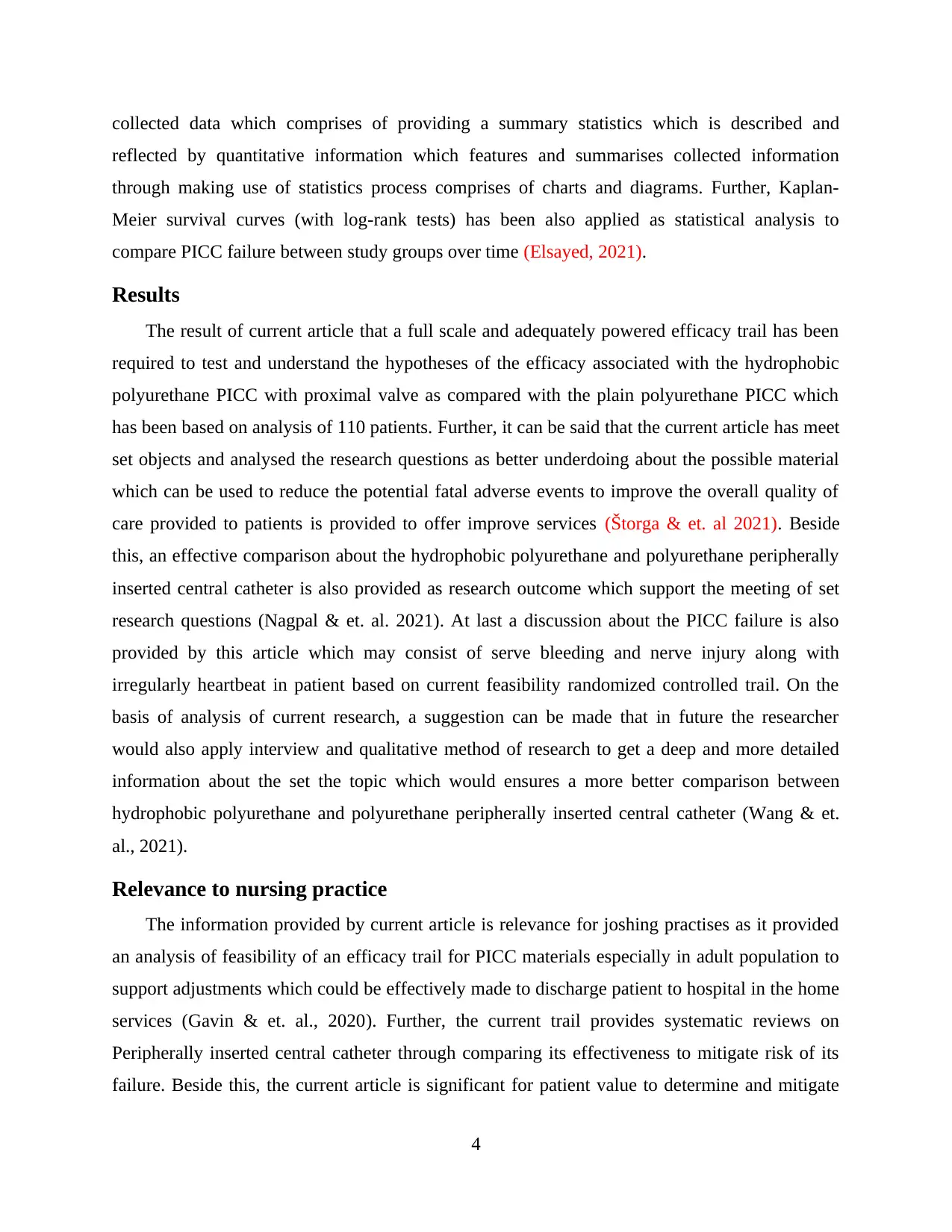
collected data which comprises of providing a summary statistics which is described and
reflected by quantitative information which features and summarises collected information
through making use of statistics process comprises of charts and diagrams. Further, Kaplan-
Meier survival curves (with log-rank tests) has been also applied as statistical analysis to
compare PICC failure between study groups over time (Elsayed, 2021).
Results
The result of current article that a full scale and adequately powered efficacy trail has been
required to test and understand the hypotheses of the efficacy associated with the hydrophobic
polyurethane PICC with proximal valve as compared with the plain polyurethane PICC which
has been based on analysis of 110 patients. Further, it can be said that the current article has meet
set objects and analysed the research questions as better underdoing about the possible material
which can be used to reduce the potential fatal adverse events to improve the overall quality of
care provided to patients is provided to offer improve services (Štorga & et. al 2021). Beside
this, an effective comparison about the hydrophobic polyurethane and polyurethane peripherally
inserted central catheter is also provided as research outcome which support the meeting of set
research questions (Nagpal & et. al. 2021). At last a discussion about the PICC failure is also
provided by this article which may consist of serve bleeding and nerve injury along with
irregularly heartbeat in patient based on current feasibility randomized controlled trail. On the
basis of analysis of current research, a suggestion can be made that in future the researcher
would also apply interview and qualitative method of research to get a deep and more detailed
information about the set the topic which would ensures a more better comparison between
hydrophobic polyurethane and polyurethane peripherally inserted central catheter (Wang & et.
al., 2021).
Relevance to nursing practice
The information provided by current article is relevance for joshing practises as it provided
an analysis of feasibility of an efficacy trail for PICC materials especially in adult population to
support adjustments which could be effectively made to discharge patient to hospital in the home
services (Gavin & et. al., 2020). Further, the current trail provides systematic reviews on
Peripherally inserted central catheter through comparing its effectiveness to mitigate risk of its
failure. Beside this, the current article is significant for patient value to determine and mitigate
4
reflected by quantitative information which features and summarises collected information
through making use of statistics process comprises of charts and diagrams. Further, Kaplan-
Meier survival curves (with log-rank tests) has been also applied as statistical analysis to
compare PICC failure between study groups over time (Elsayed, 2021).
Results
The result of current article that a full scale and adequately powered efficacy trail has been
required to test and understand the hypotheses of the efficacy associated with the hydrophobic
polyurethane PICC with proximal valve as compared with the plain polyurethane PICC which
has been based on analysis of 110 patients. Further, it can be said that the current article has meet
set objects and analysed the research questions as better underdoing about the possible material
which can be used to reduce the potential fatal adverse events to improve the overall quality of
care provided to patients is provided to offer improve services (Štorga & et. al 2021). Beside
this, an effective comparison about the hydrophobic polyurethane and polyurethane peripherally
inserted central catheter is also provided as research outcome which support the meeting of set
research questions (Nagpal & et. al. 2021). At last a discussion about the PICC failure is also
provided by this article which may consist of serve bleeding and nerve injury along with
irregularly heartbeat in patient based on current feasibility randomized controlled trail. On the
basis of analysis of current research, a suggestion can be made that in future the researcher
would also apply interview and qualitative method of research to get a deep and more detailed
information about the set the topic which would ensures a more better comparison between
hydrophobic polyurethane and polyurethane peripherally inserted central catheter (Wang & et.
al., 2021).
Relevance to nursing practice
The information provided by current article is relevance for joshing practises as it provided
an analysis of feasibility of an efficacy trail for PICC materials especially in adult population to
support adjustments which could be effectively made to discharge patient to hospital in the home
services (Gavin & et. al., 2020). Further, the current trail provides systematic reviews on
Peripherally inserted central catheter through comparing its effectiveness to mitigate risk of its
failure. Beside this, the current article is significant for patient value to determine and mitigate
4
⊘ This is a preview!⊘
Do you want full access?
Subscribe today to unlock all pages.

Trusted by 1+ million students worldwide
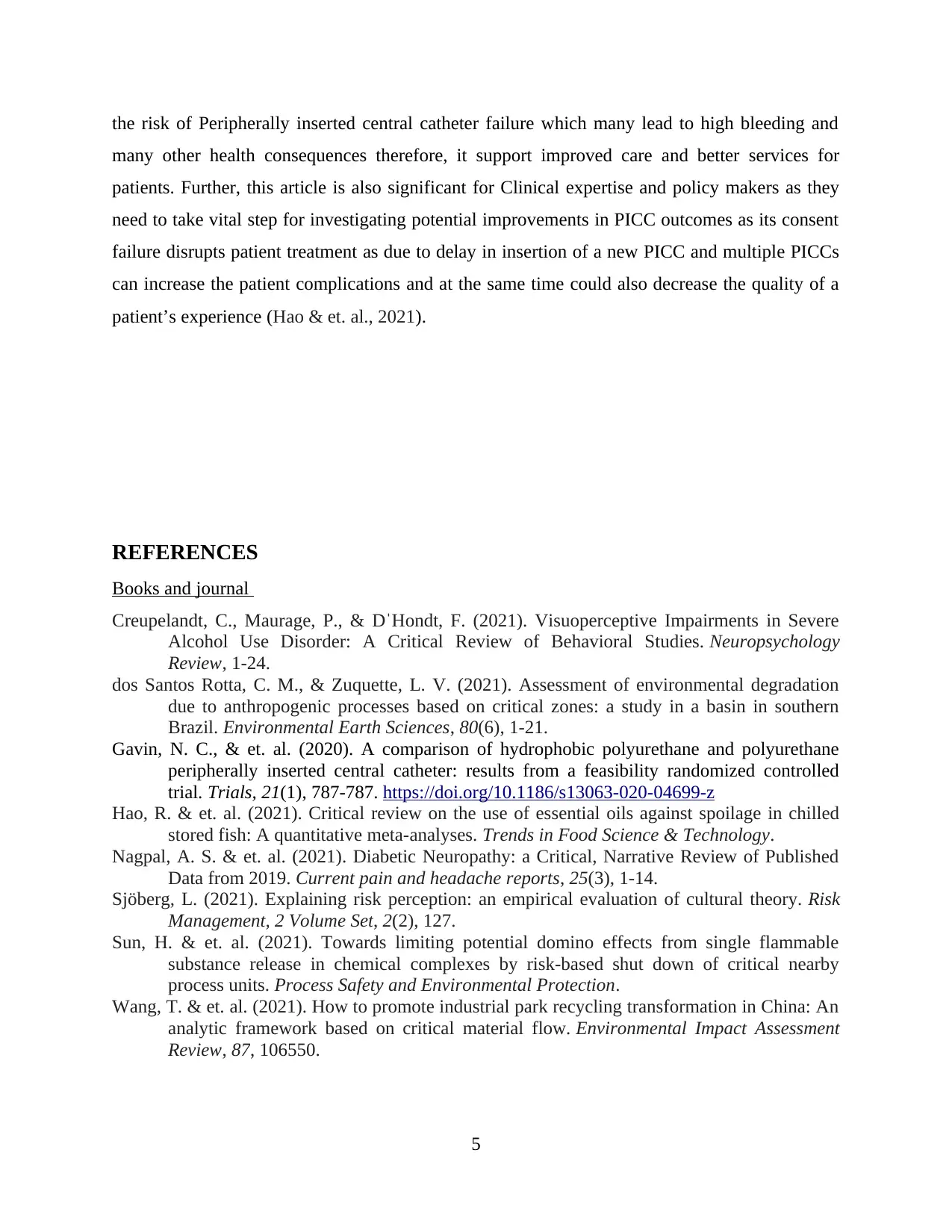
the risk of Peripherally inserted central catheter failure which many lead to high bleeding and
many other health consequences therefore, it support improved care and better services for
patients. Further, this article is also significant for Clinical expertise and policy makers as they
need to take vital step for investigating potential improvements in PICC outcomes as its consent
failure disrupts patient treatment as due to delay in insertion of a new PICC and multiple PICCs
can increase the patient complications and at the same time could also decrease the quality of a
patient’s experience (Hao & et. al., 2021).
REFERENCES
Books and journal
Creupelandt, C., Maurage, P., & DˈHondt, F. (2021). Visuoperceptive Impairments in Severe
Alcohol Use Disorder: A Critical Review of Behavioral Studies. Neuropsychology
Review, 1-24.
dos Santos Rotta, C. M., & Zuquette, L. V. (2021). Assessment of environmental degradation
due to anthropogenic processes based on critical zones: a study in a basin in southern
Brazil. Environmental Earth Sciences, 80(6), 1-21.
Gavin, N. C., & et. al. (2020). A comparison of hydrophobic polyurethane and polyurethane
peripherally inserted central catheter: results from a feasibility randomized controlled
trial. Trials, 21(1), 787-787. https://doi.org/10.1186/s13063-020-04699-z
Hao, R. & et. al. (2021). Critical review on the use of essential oils against spoilage in chilled
stored fish: A quantitative meta-analyses. Trends in Food Science & Technology.
Nagpal, A. S. & et. al. (2021). Diabetic Neuropathy: a Critical, Narrative Review of Published
Data from 2019. Current pain and headache reports, 25(3), 1-14.
Sjöberg, L. (2021). Explaining risk perception: an empirical evaluation of cultural theory. Risk
Management, 2 Volume Set, 2(2), 127.
Sun, H. & et. al. (2021). Towards limiting potential domino effects from single flammable
substance release in chemical complexes by risk-based shut down of critical nearby
process units. Process Safety and Environmental Protection.
Wang, T. & et. al. (2021). How to promote industrial park recycling transformation in China: An
analytic framework based on critical material flow. Environmental Impact Assessment
Review, 87, 106550.
5
many other health consequences therefore, it support improved care and better services for
patients. Further, this article is also significant for Clinical expertise and policy makers as they
need to take vital step for investigating potential improvements in PICC outcomes as its consent
failure disrupts patient treatment as due to delay in insertion of a new PICC and multiple PICCs
can increase the patient complications and at the same time could also decrease the quality of a
patient’s experience (Hao & et. al., 2021).
REFERENCES
Books and journal
Creupelandt, C., Maurage, P., & DˈHondt, F. (2021). Visuoperceptive Impairments in Severe
Alcohol Use Disorder: A Critical Review of Behavioral Studies. Neuropsychology
Review, 1-24.
dos Santos Rotta, C. M., & Zuquette, L. V. (2021). Assessment of environmental degradation
due to anthropogenic processes based on critical zones: a study in a basin in southern
Brazil. Environmental Earth Sciences, 80(6), 1-21.
Gavin, N. C., & et. al. (2020). A comparison of hydrophobic polyurethane and polyurethane
peripherally inserted central catheter: results from a feasibility randomized controlled
trial. Trials, 21(1), 787-787. https://doi.org/10.1186/s13063-020-04699-z
Hao, R. & et. al. (2021). Critical review on the use of essential oils against spoilage in chilled
stored fish: A quantitative meta-analyses. Trends in Food Science & Technology.
Nagpal, A. S. & et. al. (2021). Diabetic Neuropathy: a Critical, Narrative Review of Published
Data from 2019. Current pain and headache reports, 25(3), 1-14.
Sjöberg, L. (2021). Explaining risk perception: an empirical evaluation of cultural theory. Risk
Management, 2 Volume Set, 2(2), 127.
Sun, H. & et. al. (2021). Towards limiting potential domino effects from single flammable
substance release in chemical complexes by risk-based shut down of critical nearby
process units. Process Safety and Environmental Protection.
Wang, T. & et. al. (2021). How to promote industrial park recycling transformation in China: An
analytic framework based on critical material flow. Environmental Impact Assessment
Review, 87, 106550.
5
Paraphrase This Document
Need a fresh take? Get an instant paraphrase of this document with our AI Paraphraser
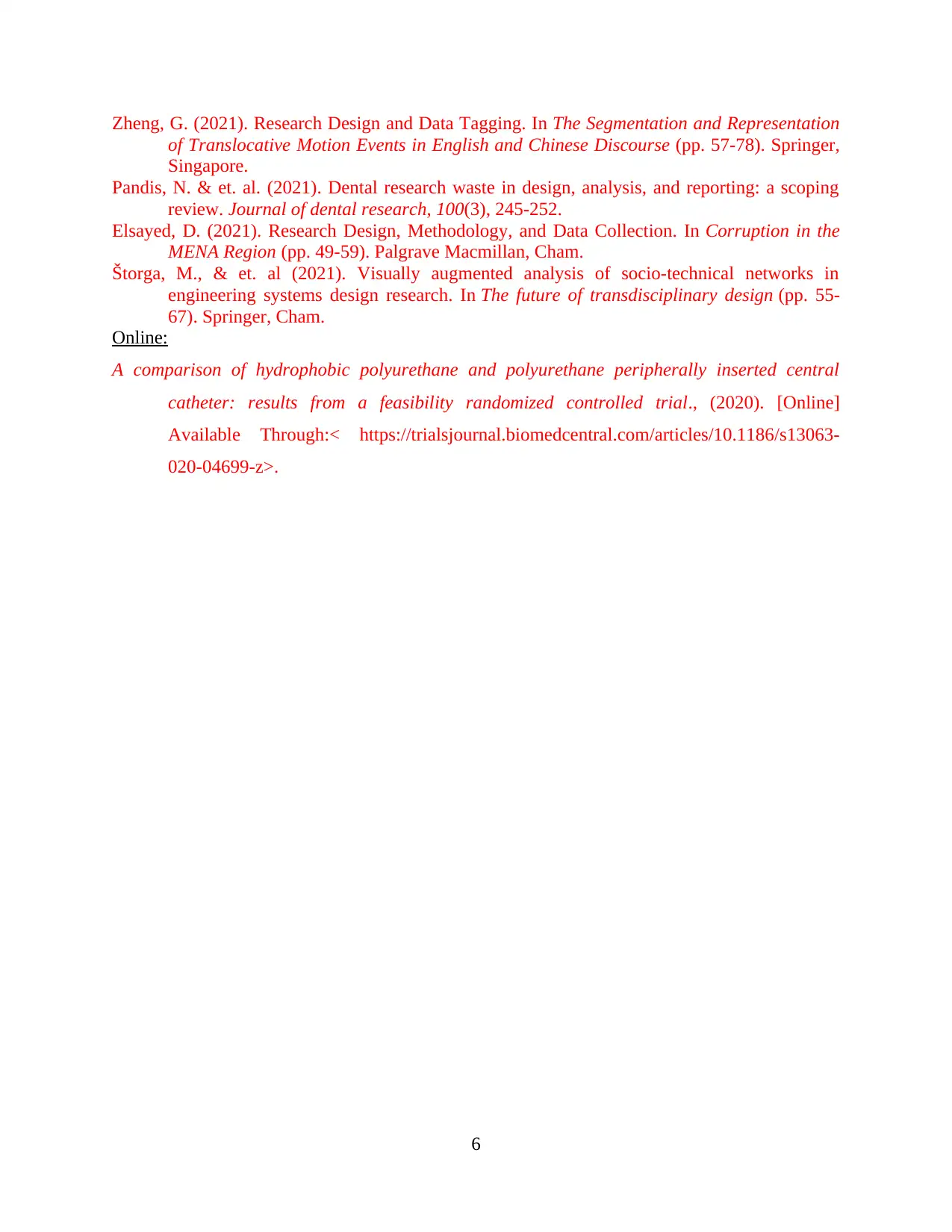
Zheng, G. (2021). Research Design and Data Tagging. In The Segmentation and Representation
of Translocative Motion Events in English and Chinese Discourse (pp. 57-78). Springer,
Singapore.
Pandis, N. & et. al. (2021). Dental research waste in design, analysis, and reporting: a scoping
review. Journal of dental research, 100(3), 245-252.
Elsayed, D. (2021). Research Design, Methodology, and Data Collection. In Corruption in the
MENA Region (pp. 49-59). Palgrave Macmillan, Cham.
Štorga, M., & et. al (2021). Visually augmented analysis of socio-technical networks in
engineering systems design research. In The future of transdisciplinary design (pp. 55-
67). Springer, Cham.
Online:
A comparison of hydrophobic polyurethane and polyurethane peripherally inserted central
catheter: results from a feasibility randomized controlled trial., (2020). [Online]
Available Through:< https://trialsjournal.biomedcentral.com/articles/10.1186/s13063-
020-04699-z>.
6
of Translocative Motion Events in English and Chinese Discourse (pp. 57-78). Springer,
Singapore.
Pandis, N. & et. al. (2021). Dental research waste in design, analysis, and reporting: a scoping
review. Journal of dental research, 100(3), 245-252.
Elsayed, D. (2021). Research Design, Methodology, and Data Collection. In Corruption in the
MENA Region (pp. 49-59). Palgrave Macmillan, Cham.
Štorga, M., & et. al (2021). Visually augmented analysis of socio-technical networks in
engineering systems design research. In The future of transdisciplinary design (pp. 55-
67). Springer, Cham.
Online:
A comparison of hydrophobic polyurethane and polyurethane peripherally inserted central
catheter: results from a feasibility randomized controlled trial., (2020). [Online]
Available Through:< https://trialsjournal.biomedcentral.com/articles/10.1186/s13063-
020-04699-z>.
6
1 out of 8
Related Documents
Your All-in-One AI-Powered Toolkit for Academic Success.
+13062052269
info@desklib.com
Available 24*7 on WhatsApp / Email
![[object Object]](/_next/static/media/star-bottom.7253800d.svg)
Unlock your academic potential
Copyright © 2020–2025 A2Z Services. All Rights Reserved. Developed and managed by ZUCOL.




